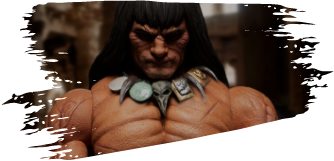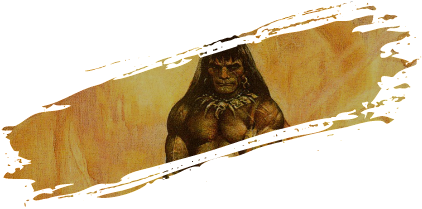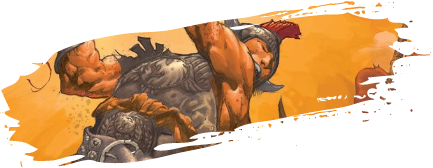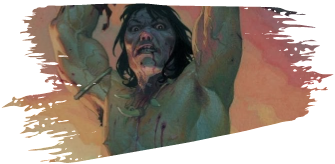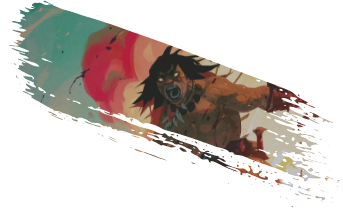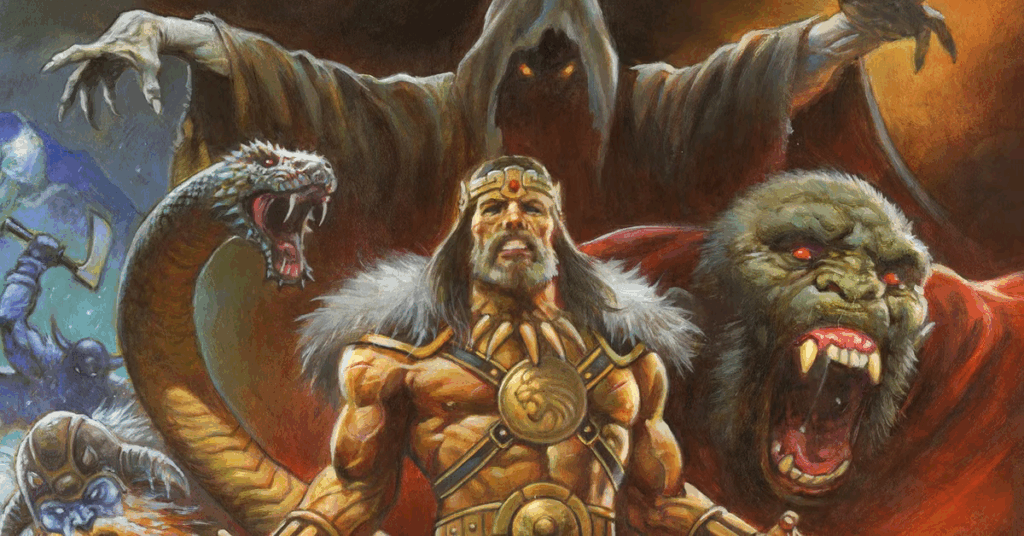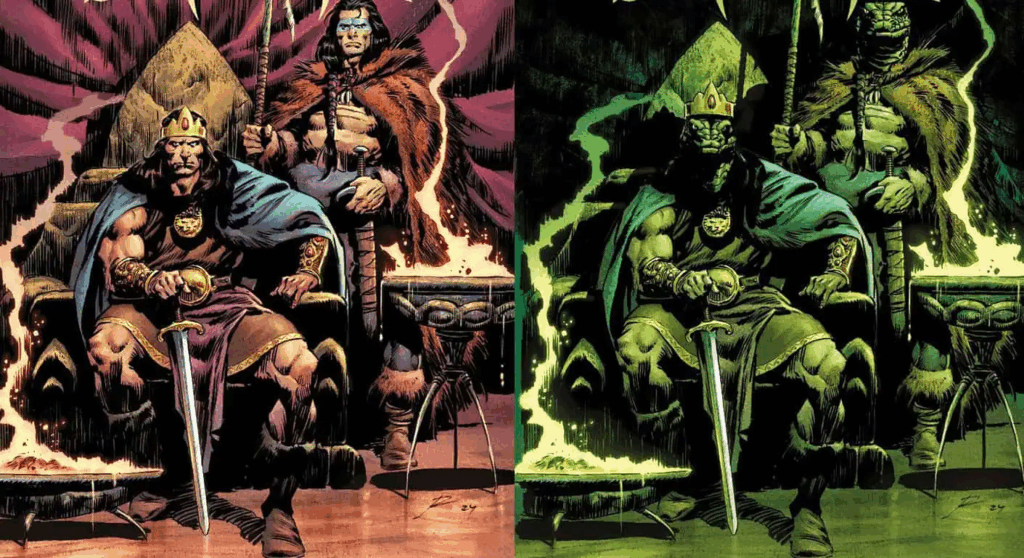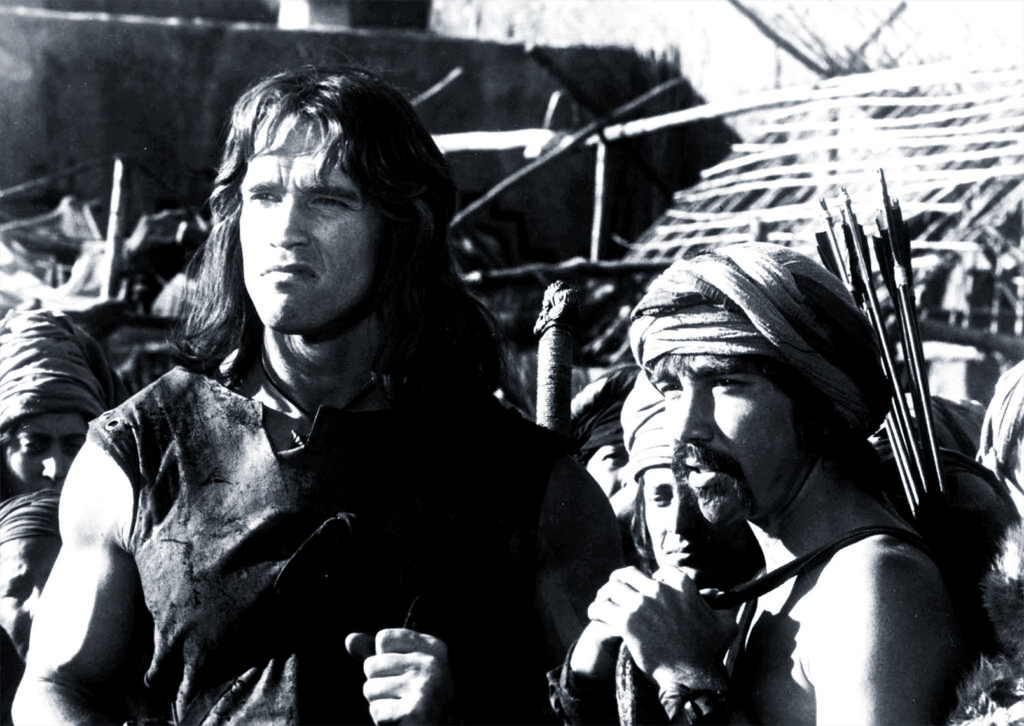
In 1982, a film emerged from the desert sands of Spain that would forever change how fantasy is portrayed on screen. Not with dazzling magical effects or fantastical creatures, but with gritty authenticity. John Milius’s Conan the Barbarian stands apart from its genre contemporaries precisely because it refuses to feel like a genre film at all.
While countless fantasy movies fade into the mists of memory, the image of Arnold Schwarzenegger standing defiantly atop a mountain of corpses endures. The haunting melody of Basil Poledouris’s “Riders of Doom” still raises goosebumps. But what alchemy transformed Robert E. Howard’s pulp tales into this timeless cinematic achievement?
Journey with us beyond the matte paintings and into the real mountains of Almería, where an uncompromising director and his dedicated team forged an entire world where steel, sorcery, and sandals meet blood, sweat, and authentic craftsmanship.
The Finding of the Setting of Conan the Barbarian
The quest to bring Robert E. Howard’s mythical Hyborian Age to life began with an ambitious vision, but finding real-world locations to embody this ancient fantasy realm proved challenging. John Milius’s production initially set its sights on the rugged terrains of Germany and Eastern Europe, eventually settling on Yugoslavia for pre-production. However, after four months of preparation, political instability and infrastructure limitations forced a dramatic pivot.
Spain emerged as the salvation for Conan’s world, as the diverse terrains of Spain’s Almería provided the perfect canvas for different facets of the Hyborian realm. Majestic mountains rose to become the imposing setting for the Temple of Set, while expansive sand dunes and stark salt marshes offered otherworldly backdrops that felt both ancient and timeless.
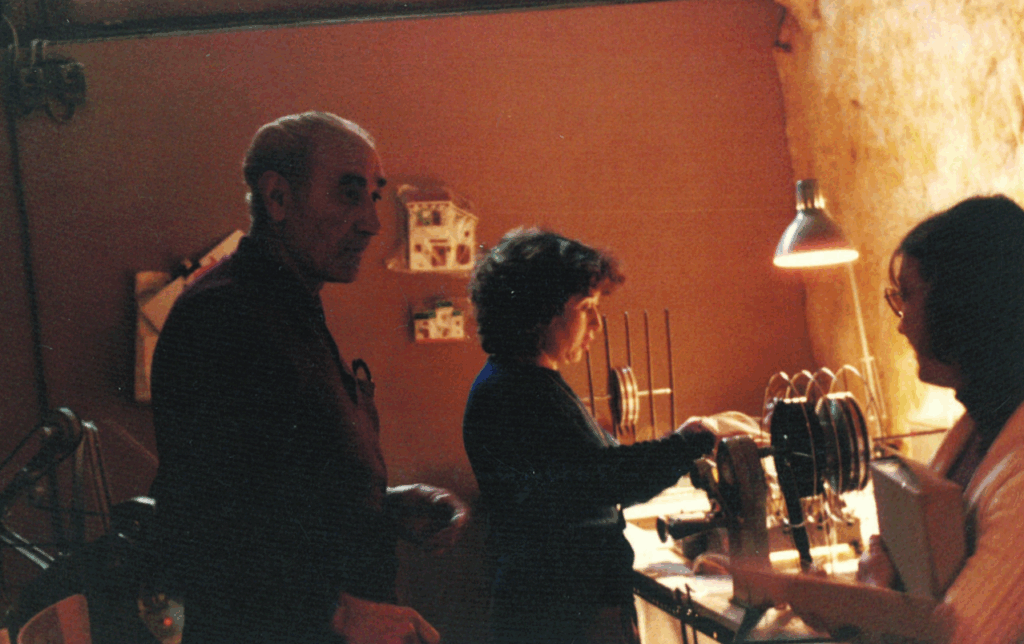
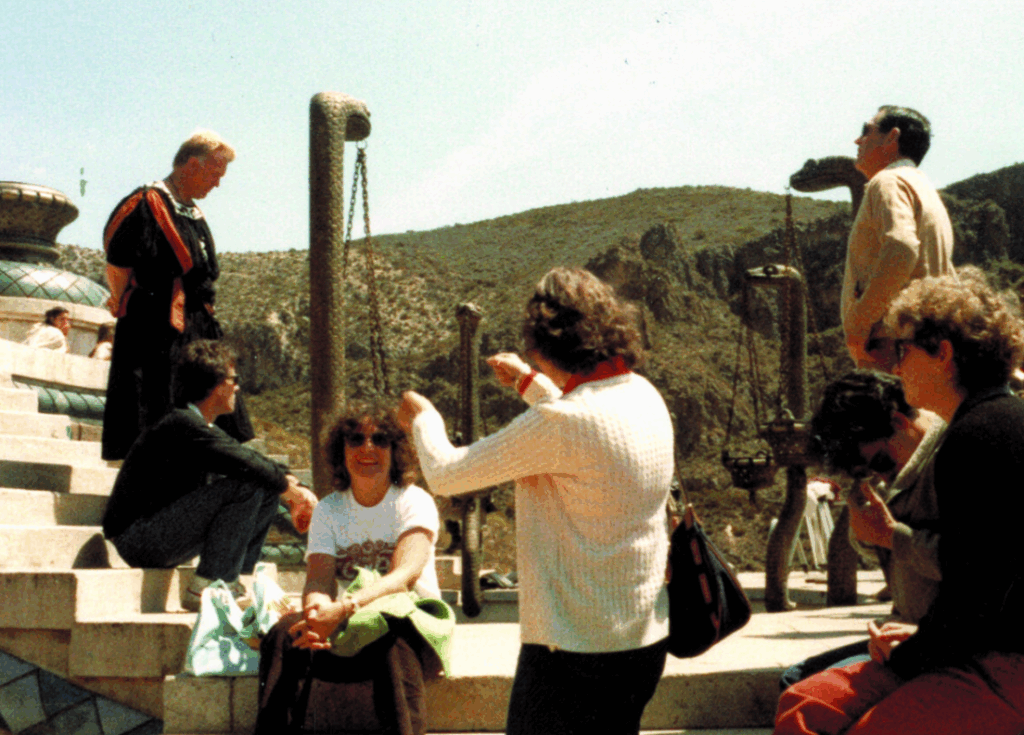
Interestingly, the Spanish landscape itself became an essential character in the film’s visual storytelling. The harsh, unforgiving terrain underscored the brutality of Conan’s world, while the natural grandeur elevated the epic scale of his journey. Through Milius’s lens, these real Spanish locations transformed into the lost continent where barbarians roamed, ancient gods were worshipped, and steel determined one’s destiny.
This foundation of geographical authenticity would be crucial for Ron Cobb’s production design, which would further transform these Spanish locations into a fully realized vision of Howard’s world.
Ron Cobb’s Grounded Fantasy
While the Spanish landscape provided the physical canvas for the Hyborian age, it was Production Designer Ron Cobb who truly breathed life into Conan’s world through a meticulous design philosophy that balanced fantasy with believability. Cobb approached the challenge with a historian’s eye and an artist’s imagination, seeking to “undo history” rather than simply create another generic sword-and-sorcery realm.
The genius of Cobb’s work lay in his seamless blending of diverse cultural influences as he drew inspiration from Greco-Roman architecture, Viking artistry, and Mongol aesthetics. Each structure, weapon, and costume appeared to have evolved naturally from this fictional civilization’s needs and beliefs, rather than being designed merely to look exotic or fantastical.
Symbolism permeated every aspect of Cobb’s designs, most notably through the pervasive two-headed snake emblem representing the Cult of Set. This symbol appeared throughout the film, subtly reinforcing the omnipresent threat of Thulsa Doom’s influence. Such attention to symbolic detail gave this iteration of the Hyborian Age a cultural depth that extended beyond what was explicitly shown on screen.
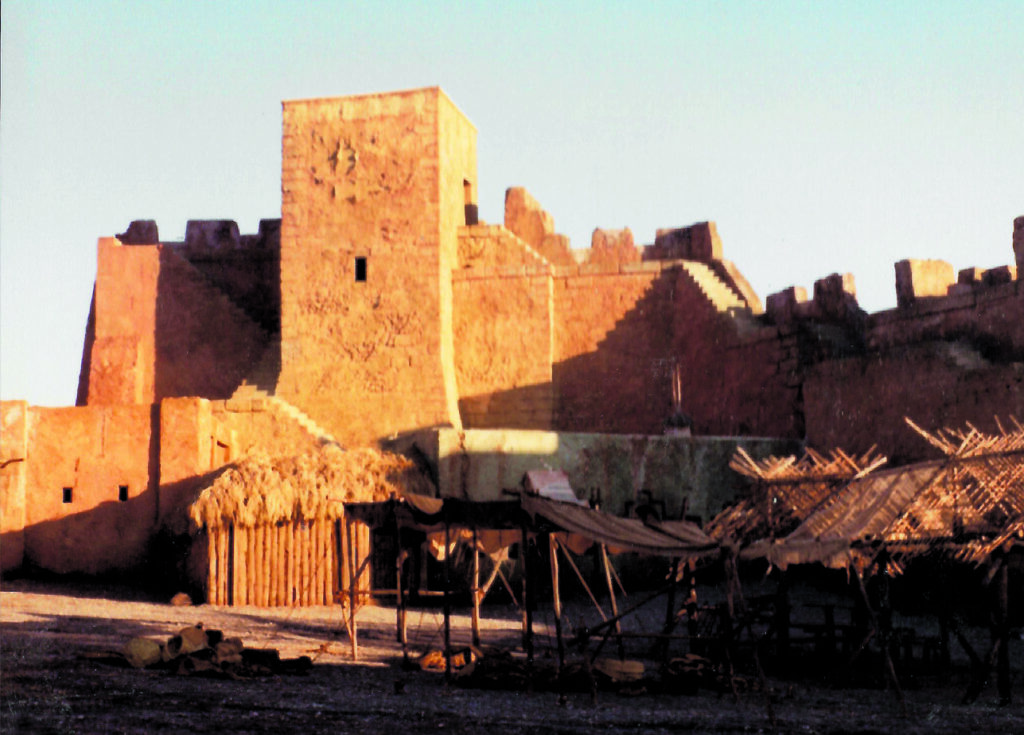
Perhaps most importantly, Cobb insisted that everything in his designs needed to look like it would “really work.” From the mechanisms of the buildings to the functionality of weapons, his creations were grounded in practical engineering principles, lending a tactile authenticity that fantasy films often lack. This commitment to practicality extended to the film’s visual effects approach, where miniatures and foreground models were preferred over traditional matte paintings, creating a more tangible sense of reality.
The collaborative relationship between Cobb and Special Effects creator Emilio Ruiz brought these visions to three-dimensional life. Their preference for physical, practical models – especially when creating illusions of scale for cities like Shadizar – meant that even the most fantastic elements of Conan’s world maintained a visceral, earthy quality. Through this approach, viewers were able to genuinely experience a lost civilization brought back to life.
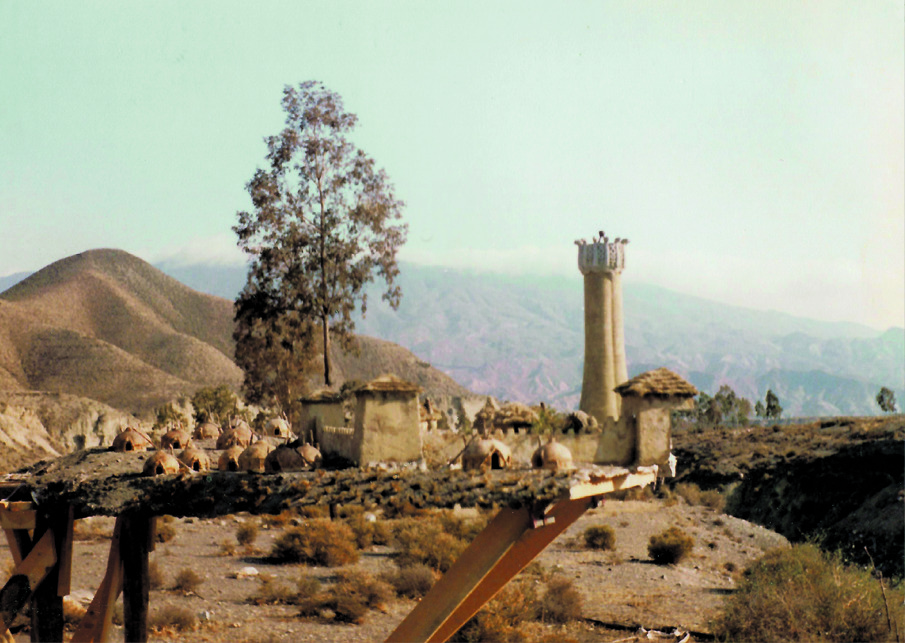
The world of Conan the Barbarian is perhaps most vividly realized through its unforgettable set pieces, each designed not merely as a backdrop but as a vital storytelling element that communicates the themes and tensions of Howard’s world.
The Iconic Set Pieces of Conan the Barbarian (1982)
The Temple of Set
No location better embodies the corrupting power of Thulsa Doom’s cult than the magnificent Temple of Set. Ron Cobb’s design choices were deliberately symbolic: a mandala-like configuration drawing followers toward a sunken circular pit, dominated by a central phallic pillar that represented the cult’s power. The flesh-toned marble of the interior, enhanced by the sensual interplay of flame and smoke, created an atmosphere both seductive and menacing which perfectly captured the allure of Doom’s twisted philosophy.
What makes this achievement even more remarkable is the sheer scale of its execution. Built full-scale on location at Peñón de Bernal in Almería, this massive undertaking was overseen by production manager Aldo Puccini, who worked primarily from conceptual sketches rather than detailed technical drawings. As the largest and most expensive set of the production – stretching 160 feet in length, rising 72 feet high, featuring 120 steps, and costing an unprecedented $350,000 (which is over $1.1 million in 2025, adjusted for inflation) – the Temple needed to accommodate 1,500 extras and crew while maintaining its imposing presence. The result was a structure so convincing that it seemed carved from the mountain itself, a perfect manifestation of Doom’s ancient and terrible power.
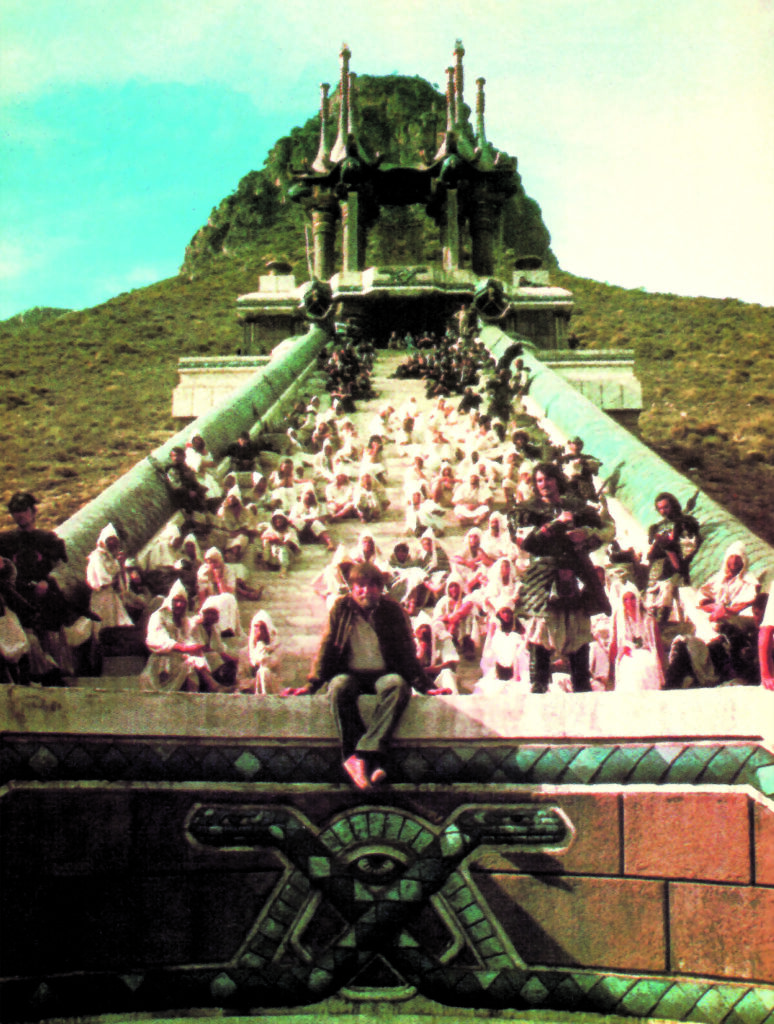
The Tree of Woe
Perhaps no set piece in the film communicates suffering and defiance more powerfully than the iconic Tree of Woe. Conceived by Milius as a “reverse crucifixion” where Conan would attack the vulture rather than accept his fate, this stark setting became one of the film’s most enduring images.
The technical challenges of creating this seemingly simple set were considerable. Filmed near the Almería coast over three days, the production team constructed a tree of plaster and Styrofoam built over a metal and wooden skeleton. To ensure consistent lighting and shadows throughout the filming, the entire structure was mounted on a turntable that could be repositioned as needed. Practicality extended to Schwarzenegger’s comfort as well, so a hidden bicycle seat was ingeniously built into the tree to support the actor during the lengthy shoot.
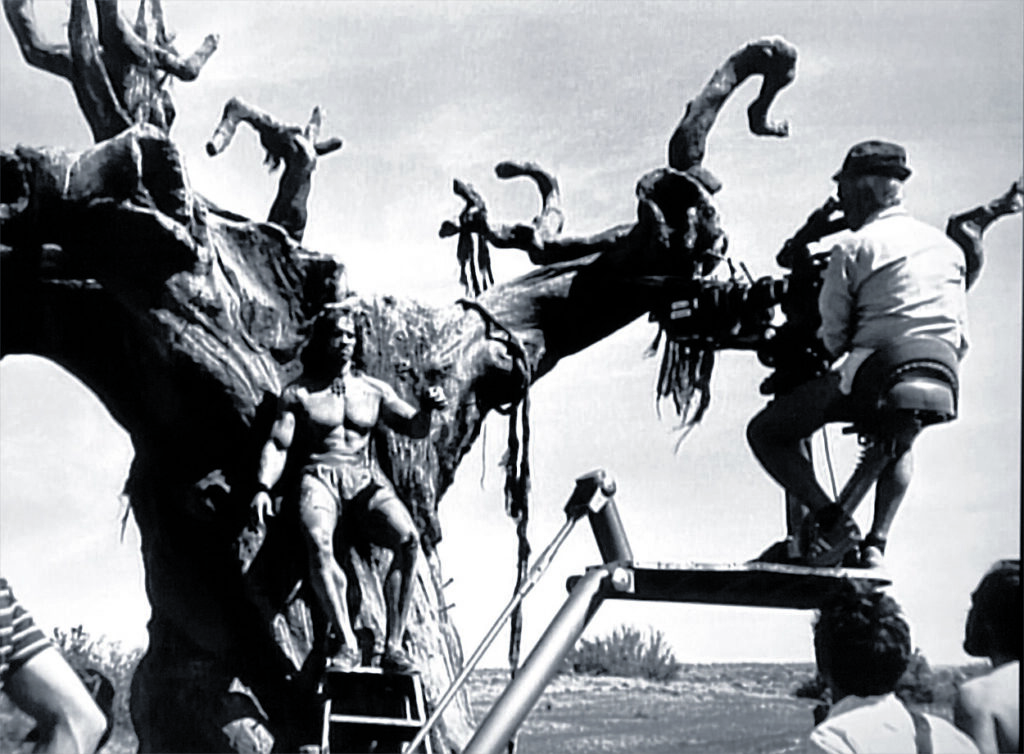
The vulture sequence posed its own unique challenges. Initially working with a real bird, the team later switched to a taxidermy puppet operated by technicians. When Schwarzenegger had to bite the puppet during the scene, he was required to use mouthwash afterward due to concerns about potential cross-infection.
Through these meticulously crafted environments, the filmmakers achieved fantasy settings that felt lived-in, historically plausible, and charged with symbolic meaning, a harmony of vision that would be further enhanced by the film’s extraordinary musical score.
The Soundtrack of Conan the Barbarian (1982)
In creating Conan the Barbarian, John Milius wanted to do more than create a movie. Instead, he sought an operatic experience where music would carry the drama in dialogue-sparse sections. This vision required a composer who could craft themes as powerful and primal as the Hyborian Age itself. In Basil Poledouris, Milius found the perfect musical partner.
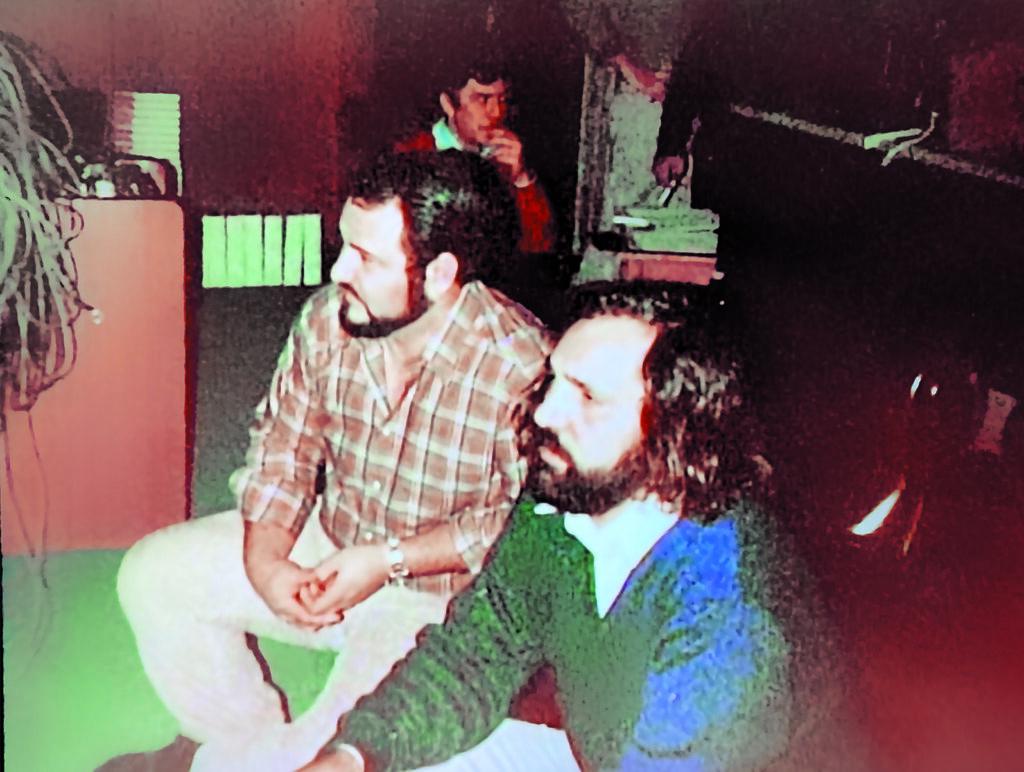
The collaboration between director and composer began early, with Poledouris developing key themes like the iconic “Riddle of Steel” before and during filming. This early integration allowed the music to become inseparable from the storytelling itself. The “Riddle of Steel” motif functioned as what Poledouris called “mythological glue”, a recurring theme that bound Conan’s journey, his father’s wisdom, and the film’s central philosophical questions into a cohesive whole.
Rather than mimicking established historical styles, Poledouris sought to create a truly “pre-historic” sound that rose above specific cultural references. His approach focused on evoking primal emotion, as he wanted his music to work on a “gut level” by resurrecting “primitive memories of fear” during action sequences.
The technical execution of this music was as ambitious as Poledouris’ conceptual vision. Recording with a large orchestra and choir in Rome, Poledouris employed specific instrumentation techniques that created Conan’s signature sonic landscape. The pioneering Musync computer system allowed for precise timing and synchronization, particularly vital for complex cues like the gradually accelerating tempo in the Wheel of Pain sequence, where metallic percussion tracked Conan’s transformation from slave to warrior.
Each pivotal moment in the film received its own distinctive musical treatment: the village attack featured an Orff-inspired choir that amplified the menace of Thulsa Doom’s arrival; Valeria’s funeral pyre was scored with a more intimate, eloquent arrangement that conveyed profound loss amidst the epic scale. This tailored approach ensured the music always served the emotional weight of each scene rather than simply providing atmosphere.
Despite the grand orchestration and stereo recording, budget considerations ultimately led to the film’s mono mix release. The score’s impact was immediate and lasting, earning universal praise even from critics who found fault with other aspects of the film.
The Enduring Legacy of Conan the Barbarian
The unified impact of Milius’s vision created something far greater than the sum of its parts. Each element reinforced the others, combining to transport viewers to the Hyborian Age in a way that felt viscerally real.
Critics at the time offered mixed reviews, some praising the film’s brutal majesty while others found fault with its pacing or departures from Howard’s original stories. Yet audiences responded powerfully, driving box office success and cementing Conan’s place in popular culture. The film grossed over $130 million worldwide against its $20 million budget, a ringing endorsement of Milius’s uncompromising approach to giving viewers what they were hungry for: fantasy with substance.
Four decades later, the sights and sounds of Conan the Barbarian continue to captivate new generations of viewers. The Spanish mountains still echo with Cimmerian battle cries, the Temple of Set still inspires dread, and the mournful strings of Valeria’s funeral theme still bring tears. In creating a Hyborian Age that feels like it could have truly existed in our distant past, Milius and his team made myth feel like history, and in doing so, created a legend of their own.
Crave more insights into the making of this legendary film? Discover the full, untold story of Conan’s journey from script to screen in “The Official Story of the Film Conan the Barbarian.” This definitive volume contains hundreds of behind-the-scenes photographs, exclusive interviews, and detailed production secrets that even the most devoted fans haven’t seen.
From Arnold’s grueling preparation to the last-minute special effects innovations, this book is your key to unlocking the mysteries behind the film that redefined fantasy cinema. Whether you’re a lifelong Conan devotee or discovering the Cimmerian’s world for the first time, this book is a must-have.
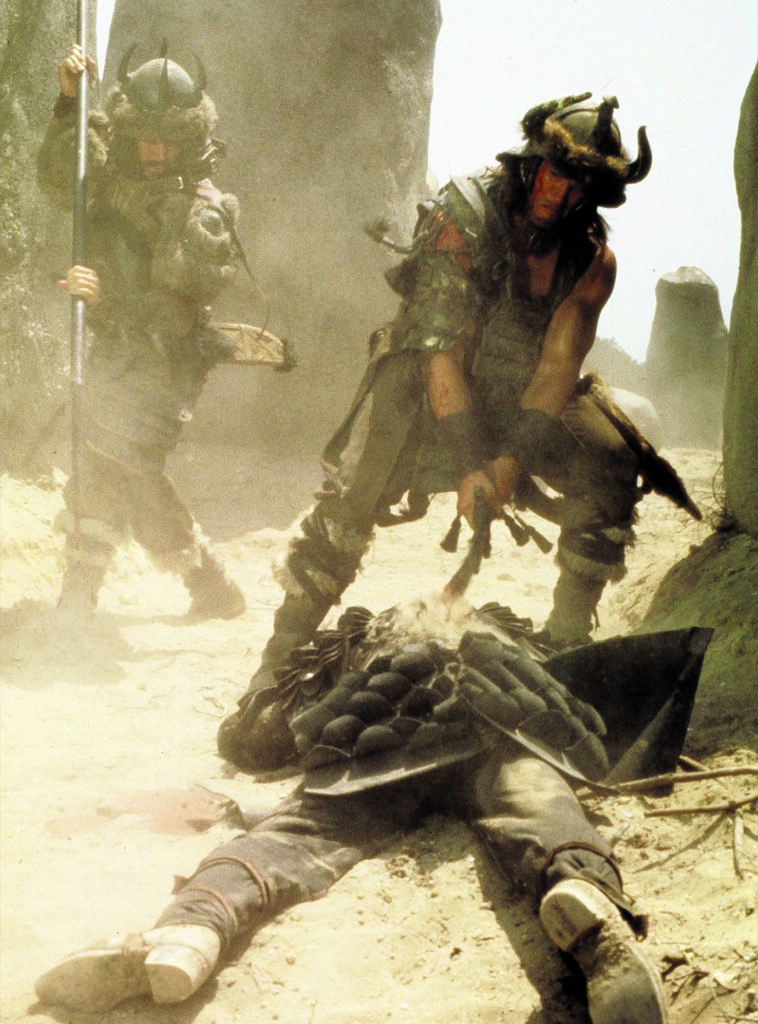

Lo Terry
In his effort to help Heroic Signatures tell legendary stories, Lo Terry does a lot. Sometimes, that means spearheading an innovative, AI-driven tavern adventure. In others it means writing words in the voice of a mischievous merchant for people to chuckle at. It's a fun time.


